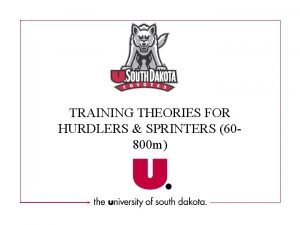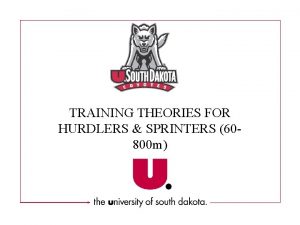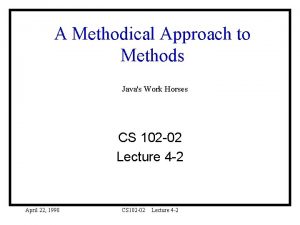A Methodical Approach for Developing High Hurdlers Karim


















- Slides: 18

A Methodical Approach for Developing High Hurdlers Karim Abdel Wahab Sprints, Hurdles and Relays coach Colorado State University coachkarim@colostate. edu 970 -213 -9497

Establishing a High Hurdling Development Philosophy Stride length and stride frequency are the parameters for faster sprinting. What about hurdling? Stride frequency is the prime focus of the training plan. What does it mean for hurdlers to be “aggressive”? : Hurdlers have to be master shufflers! Can you beat the person next to you without over striding? ! The “Prime focus” of the high hurdles development training plan has to be the turnover “shuffling development between hurdles”. Hurdle clearance stride length: The consistency in the “average” stride length between the hurdles, as well as, the length of the hurdle clearance stride are the keys for targeting turnover “shuffling” development in between the hurdles

9 ways to minimize loss of horizontal velocity Next

Minimize loss of horizontal velocity 1 - Getting in a tall body posture early enough before the first hurdle. 2 - “Power leg” and “Cut step” concepts at hurdle take-off (Step over knee, step over knee and step over calves to plant foot at takeoff) 3 - and at re-accelerating coming off the hurdle (Hurdle – Create speed – Hurdle)

Minimize loss of horizontal velocity 4 - Taking off at an appropriate distance from the hurdles based on the hurdlers’ height/ anthropometric differences (The lower over the hurdle, the faster the time will be), “Explode from far”!

Minimize loss of horizontal velocity

Minimize loss of horizontal velocity 5 - Leading with the knee at the lead leg during hurdle take-off 6 - Minimizing the amortization at lead leg ground contact while landing after the hurdle

Minimize loss of horizontal velocity 5 - 6 -

Minimize loss of horizontal velocity 7 - Eliminating the “slack” in the system while sprinting between the hurdles

Minimize loss of horizontal velocity 8 - Diving “through” Not into the hurdle (No rocking back!!) A- Diving starts from the ground, it starts with planting the take-off foot B- Gets the lead leg down fast without forcing it C- Keeps trail knee “tight” coming off the hurdle D- Creates room for shuffling between hurdles The best of the best dive “through the hurdles”

Minimize loss of horizontal velocity

Minimize loss of horizontal velocity 9 - Minimum Deviation from sprinting mechanics: 1. Hips and shoulders squared forward 2. Leading with the knee at the lead leg 3. 3 -Trail knee higher than trail foot 4. Tight trail leg ( Heel close to butt and knee to the arm pit) 5. Complete trail leg action to get back to sprinting (thigh gets back to 12 o’clock) 6. Trail Knee pulled to the arm pit 7. Sprinting with the trail leg through the hurdle VS only folding it to avoid the hurdle!!! 8. Lead Arm at the direction of travel (Can’t cross sternum) elbow extends while arm swings back, hand meets trail knee “women”, hand meets trail elbow “men”, to get back to sprinting action coming off the hurdle 9. Tapping the tummy “with trail arm”, to get back to sprinting action coming off the hurdle

Develop Turnover Between Hurdles Methods: Discounting the distance Increasing the number of strides Lowering the hurdle height An ideal training plan involves all three variables mixed together and put in a progression that will lead hurdlers to get faster times throughout the season.

5 step pattern guidelines 1 - The hurdles inner spacing that is used during the training plan is typically shorter than regulation spacing, this develops turn over and proper “shuffling” capabilities for high hurdlers. 2 - Over the phases of the training plan the inner spacing progresses from shorter to longer, and occasionally regulation spacing is implemented. 3 - 5 step stride patterns are used throughout the training plan for various objectives. The average stride length used in any 5 step stride pattern mostly mirrors the desired average stride length for the 3 step stride pattern implemented in any specific phase of training. 4 - The main goal is to keep the hurdlers locked in using a consistent average stride length whether they use 3 step stride pattern or 5 step stride pattern in any given phase of training. Using 5 step stride patterns between any hurdling unit allows for velocity to carry over to a subsequent 3 step stride pattern unit. This will develop specific “shuffling” capabilities in every training phase. 5 - The distance between hurdles for the 5 step pattern can be easily calculated. First subtract the hurdle stride length out of the desired distance between hurdles for 3 step pattern. Second, divide that number by 3, then multiplying it by 5 (these are the number of step utilized in inner hurdling stride patterns). Third, add the specific hurdle clearance stride length that corresponds to your athletes’ height. 6 - Take-off and landing distances should always be the same throughout the training plan to create consistency. This will make the development of the average stride’s turnover become the prime focus of training. 7 - The table below shows the distances in meters used in the 3 step inner spacing with corresponding 5 step patterns for a 5’ 10” male and 5’ 7” female hurdlers

5 step pattern guidelines

Developing the ability to reaccelerate Notes regarding the 5 step start: In certain phases of training a 5 step start drill will be implemented. Hurdlers don’t get much velocity built into the first hurdle when starting out of 5 step approach. Without much speed build in the first hurdle there won’t be much room for error, take off foot should be planted properly “down and back” to create the cut step effect. Hurdlers need to be low over the hurdles to carry over as much velocity as possible “through the hurdle”. There is no time for floating over the hurdles, “Lead leg and trail leg are racing to the ground” at landing after the hurdle. Trail leg will have to come through tight and land explosively with a positive shin angle at ground contact to start the aggressive reacceleration and build more velocity between hurdles 1 -2. There is no tolerance for over-striding between hurdles! To get to the next hurdle faster hurdlers have to be efficient, aggressive and powerful. The coach is timing touch down units between a set of 5 hurdles and the timing units should be decreasing as the hurdlers are re-accelerating and efficiently creating more velocity. If they are not efficient and aggressive the speed curve will be slower over the 5 hurdles. Doing few reps of the 5 step start drill followed by doing few reps of 8 step start out of blocks will create contrast training effect and will help carry over the efficiency and aggressiveness developed from the 5 step start to actual hurdling!

Simple concepts for beginners 1 - Teach proper trail leg movement 2 - Teach correct foot planting at take off 3 - Teach taking-off at an appropriate distance from the hurdle (Mark the take-off) 4 - Teach quick 3 step rhythm between hurdles (Start with a 3 feet shorter than regulation then progress gradually) 5 - Teach sprinting through the hurdle (Start on lower hurdles than regulation and move the hurdle up gradually as they improve)

Questions!!!
 A methodical person
A methodical person Bing image search
Bing image search Evelin karim aziz
Evelin karim aziz Karim benali cardiologue
Karim benali cardiologue Riyas karim
Riyas karim Al karim artinya
Al karim artinya Karim dahia
Karim dahia Example of thesis statement and topic sentence
Example of thesis statement and topic sentence Karim daho
Karim daho Yazan karim
Yazan karim Yazan karim
Yazan karim Rehnuma karim
Rehnuma karim Istishab adalah
Istishab adalah Karim emile bitar twitter
Karim emile bitar twitter Dr karim aref
Dr karim aref Dr azmat karim
Dr azmat karim Uml
Uml Prof. dr. karim fereidooni herkunft
Prof. dr. karim fereidooni herkunft Keistimewaan alquran
Keistimewaan alquran

































